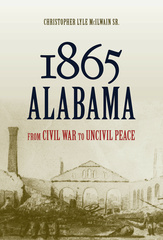
The Battle for the University of Alabama
The Perilous Path of Higher Education in the Reconstruction South
Traces the little-known story of the bitter contest for the fate of the University of Alabama after the Civil War
In The Battle for the University of Alabama, William Warren Rogers Jr. gives a fascinating account of the fierce struggle over the nature of the University of Alabama after the Civil War. Union forces reduced the campus to ruins as the war ended, and the university did not reopen until 1869. In the interregnum, powerful forces shifted the trajectory of the school. Alabama Republicans authored an egalitarian state constitution that delivered oversight of the university to the Republican Party. That set the stage for turmoil and confrontation. This book tells the story of that conflict.
In the next few years, Democrats charged Republicans with turning the university into a “radical” institution. They alleged that a handful of unqualified individuals had gained faculty positions because of their political allegiance, which resulted in the university’s academic desecration. Professors were bitterly denounced in the state newspaper press and quite personally in Tuscaloosa. Administration of the university became part of the fratricidal political debate in the state. Political violence and questions concerning race, specifically the possible integration of the university, illuminated the controversies of the Reconstruction years. Many of these questions resonate even today.
This authoritative account sets events at the University of Alabama against the backdrop of what occurred at other state universities in the Reconstruction South. The University of North Carolina experienced controversy similar to Alabama’s. At the University of Georgia, however, calm prevailed. This story of the incendiary events at Alabama’s flagship university charts new ground and provides a revelatory look into the extraordinary partisanship that characterized the South after the Civil War.
'Rogers adds precision to a less understood era in the UA and Reconstruction-era higher education. The author moves beyond the Sellers’ classic and offers fresh insights.' —Hilary Green, author of Educational Reconstruction: African American Schools in the Urban South, 1865–1890
‘From a wealth of scattered details, Rogers has constructed an engaging narrative of the postwar struggles to set the path for Alabama’s future leaders. To call the book well researched and documented is to understate the case.’ —G. Ward Hubbs, author of Searching for Freedom after the Civil War
'Warren Rogers’ book on the college experience during Reconstruction raises an important and timely topic, campus life in a time of political passion. The focus—the University of Alabama—was beset by a local Ku Klux Klan and a newspaper editor who revelled in personal violence. The result was chaos, and Republican attempts at bipartisan balance didn’t help. Rogers’ book demonstrates the impossibility of protecting free speech for Alabama’s few white Republicans while maintaining racial exclusion as state policy. The outcome set the stage for the integration conflict on the campus in the mid-1950s, and on the famed George Wallace confrontation in 1963. The book thus offers a bracing look at academic freedom that will be of interest to modern readers.'
—Michael W. Fitzgerald, author of Splendid Failure: Postwar Reconstruction in the American South
List of Figures
Acknowledgments
Introduction
Chapter 1. “I Do Not Know that the Un__y of Ala. Will Ever Be Rebuilt”
Chapter 2. “Peace Is the Indispensable Condition of Education”: The Reinvigoration of Southern State Universities, 1865‒1868
Chapter 3. Faltering Renaissance
Chapter 4. “A Position Connected with the University Is Not at Present a Very Pleasant One”
Chapter 5. In Search of a President
Chapter 6. “Mrs. Partington and the Sea”
Chapter 7. “The Revered Old Intellectual Mother Will Weather the Storm”
Chapter 8. “We Have a University to Resuscitate”
Chapter 9. Courting the Commodore: The University of Alabama Lures a President
Chapter 10. Aftermath
Conclusion
Notes
Bibliography
Index











